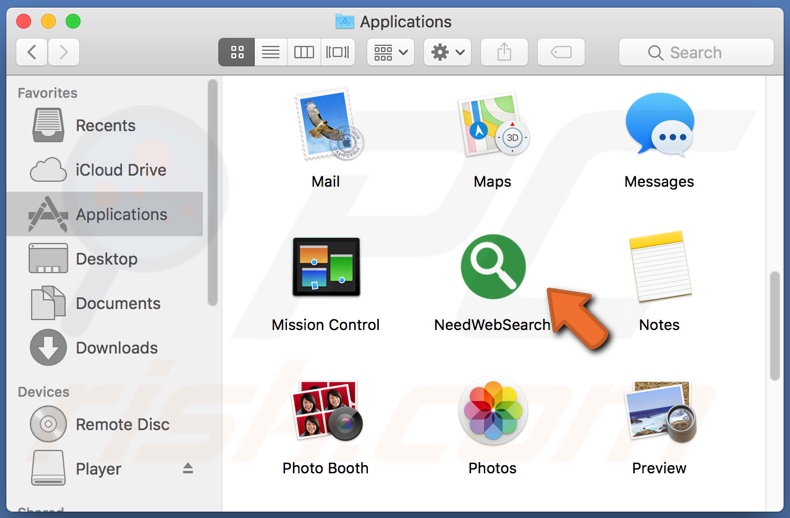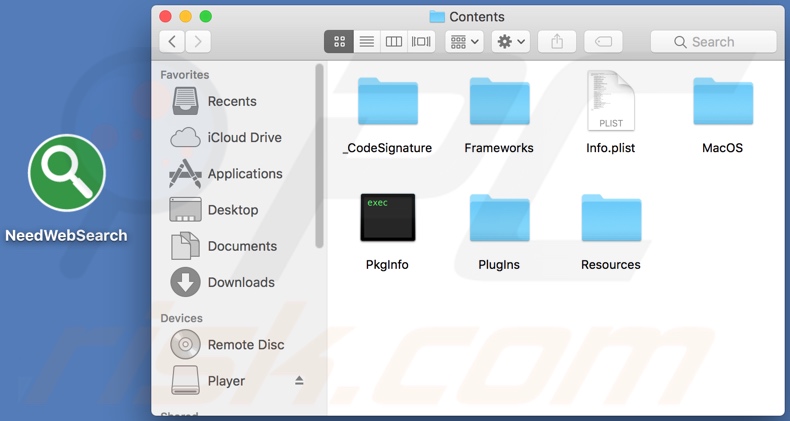Get free scan and check if your device is infected.
Remove it nowTo use full-featured product, you have to purchase a license for Combo Cleaner. Seven days free trial available. Combo Cleaner is owned and operated by RCS LT, the parent company of PCRisk.com.
What is NeedWebSearch?
The NeedWebSearch application is classified as adware. It is endorsed as a tool for improving the browsing experience and is allegedly capable of providing fast searches, accurate search results, etc. Despite this, it runs intrusive advertisement campaigns (i.e., delivers unwanted and potentially harmful ads).
Most adware-types possess data tracking capabilities, which they employ to monitor users' browsing habits. Due to dubious methods used to distribute NeedWebSearch, it is classed as a Potentially Unwanted Application (PUA).

Banners, pop-ups, coupons, and surveys are just some examples of ads displayed by adware. These intrusive ads severely affect the browsing experience and are a threat to browser/system integrity. They limit browsing speed and website visibility by overlaying web page content.
Furthermore, when clicked, they redirect to various dubious and harmful web pages. For example, sale-oriented, compromised, deceptive/scam, and even malicious sites. Some can also be triggered to execute scripts designed to download/install unwanted and malicious content (e.g. PUAs) without users' permission.
As mentioned, unwanted apps cause redirects to likewise dangerous web pages and deliver ads, however, they can also make unauthorized changes to browsers (hijack them) and promote fake search engines. Regardless of type (e.g. adware, browser hijacker, etc.), most PUAs can track data.
They use these capabilities to record browsing activity (URLs visited, pages viewed, search queries typed, etc.) and collect users' personal information (IP addresses, geolocation and other details). This private data is then shared with third parties (often, cyber criminals) seeking to generate revenue by misusing it.
In summary, PUAs (and by extension, adware) can cause browser and system infiltration/infections, and lead to serious privacy issues, financial loss and even identity theft. To ensure device and user safety, remove all suspicious applications and browser extensions/plug-ins immediately upon detection.
| Name | Ads by NeedWebSearch |
| Threat Type | Adware, Mac malware, Mac virus. |
| Symptoms | Your Mac becomes slower than normal, you see unwanted pop-up ads, you are redirected to dubious websites. |
| Distribution methods | Deceptive pop-up ads, free software installers (bundling), fake Flash Player installers, torrent file downloads. |
| Damage | Internet browser tracking (potential privacy issues), display of unwanted ads, redirects to dubious websites, loss of private information. |
| Malware Removal (Windows) |
To eliminate possible malware infections, scan your computer with legitimate antivirus software. Our security researchers recommend using Combo Cleaner. Download Combo CleanerTo use full-featured product, you have to purchase a license for Combo Cleaner. 7 days free trial available. Combo Cleaner is owned and operated by RCS LT, the parent company of PCRisk.com. |
Adware is a common type of PUA. Most of these apps share certain traits. MightyBrowser, ProdigySearch, CustomStrategic, and OutputData are just some examples of applications similar to NeedWebSearch. In fact, all PUAs have similarities. They often seem legitimate and attempt to lure users into downloading/installing them with offers of "useful" features.
In most cases, however, these features are nonoperational. PUAs have just one purpose: to generate revenue for the developers, whilst regular users receive no value. Rather than working as advertised, unwanted apps run intrusive ad campaigns, cause redirects, hijack browsers, and gather sensitive data.
How did NeedWebSearch install on my computer?
PUAs are often installed with other software inadvertently. This deceptive marketing tactic of packing normal products with unwanted or malicious content is called "bundling".
By rushing through the download/installation processes (e.g. skimming or ignoring terms, using pre-set options, skipping steps and sections, etc.), many users increase the risk of potential system infiltration and infections. Certain PUAs have "official" promotional websites, on which they are usually promoted as legitimate, functional, and free.
When clicked, intrusive advertisements can stealthily download/install these apps.
How to avoid installation of potentially unwanted applications
Research all content to verify its legitimacy, before downloading/installing. Use only official and verified download channels. Peer-to-Peer sharing networks (BitTorrent, eMule, Gnutella, etc.), unofficial and free file-hosting sites, third party downloaders and similar sources are classed as untrustworthy and should be avoided.
When downloading/installing, read the terms, explore all available options, use the "Custom/Advanced" settings, and opt-out of supplementary apps, tools, features, etc.
While typically hosted by compromised web pages, intrusive ads often appear legitimate and harmless, however, they can redirect to dubious and possibly harmful websites, such as gambling, pornography, adult-dating and others.
If you encounter ads or redirects of this kind, inspect the device and remove all suspicious applications and/or browser extensions/plug-ins without delay. If your computer is already infected with NeedWebSearch, we recommend running a scan with Combo Cleaner Antivirus for Windows to automatically eliminate this adware.
Pop-up window displayed once NeedWebSearch installation is complete:

Installation folder of NeedWebSearch adware:

Instant automatic malware removal:
Manual threat removal might be a lengthy and complicated process that requires advanced IT skills. Combo Cleaner is a professional automatic malware removal tool that is recommended to get rid of malware. Download it by clicking the button below:
DOWNLOAD Combo CleanerBy downloading any software listed on this website you agree to our Privacy Policy and Terms of Use. To use full-featured product, you have to purchase a license for Combo Cleaner. 7 days free trial available. Combo Cleaner is owned and operated by RCS LT, the parent company of PCRisk.com.
Quick menu:
- What is NeedWebSearch?
- STEP 1. Remove NeedWebSearch related files and folders from OSX.
- STEP 2. Remove NeedWebSearch ads from Safari.
- STEP 3. Remove NeedWebSearch adware from Google Chrome.
- STEP 4. Remove NeedWebSearch ads from Mozilla Firefox.
Video showing how to remove NeedWebSearch adware using Combo Cleaner:
NeedWebSearch adware removal:
Remove NeedWebSearch-related potentially unwanted applications from your "Applications" folder:

Click the Finder icon. In the Finder window, select "Applications". In the applications folder, look for "MPlayerX","NicePlayer", or other suspicious applications and drag them to the Trash. After removing the potentially unwanted application(s) that cause online ads, scan your Mac for any remaining unwanted components.
DOWNLOAD remover for malware infections
Combo Cleaner checks if your computer is infected with malware. To use full-featured product, you have to purchase a license for Combo Cleaner. 7 days free trial available. Combo Cleaner is owned and operated by RCS LT, the parent company of PCRisk.com.
Remove adware-related files and folders

Click the Finder icon, from the menu bar. Choose Go, and click Go to Folder...
 Check for adware generated files in the /Library/LaunchAgents/ folder:
Check for adware generated files in the /Library/LaunchAgents/ folder:

In the Go to Folder... bar, type: /Library/LaunchAgents/

In the "LaunchAgents" folder, look for any recently-added suspicious files and move them to the Trash. Examples of files generated by adware - "installmac.AppRemoval.plist", "myppes.download.plist", "mykotlerino.ltvbit.plist", "kuklorest.update.plist", etc. Adware commonly installs several files with the exact same string.
 Check for adware generated files in the ~/Library/Application Support/ folder:
Check for adware generated files in the ~/Library/Application Support/ folder:

In the Go to Folder... bar, type: ~/Library/Application Support/

In the "Application Support" folder, look for any recently-added suspicious folders. For example, "MplayerX" or "NicePlayer", and move these folders to the Trash.
 Check for adware generated files in the ~/Library/LaunchAgents/ folder:
Check for adware generated files in the ~/Library/LaunchAgents/ folder:

In the Go to Folder... bar, type: ~/Library/LaunchAgents/

In the "LaunchAgents" folder, look for any recently-added suspicious files and move them to the Trash. Examples of files generated by adware - "installmac.AppRemoval.plist", "myppes.download.plist", "mykotlerino.ltvbit.plist", "kuklorest.update.plist", etc. Adware commonly installs several files with the exact same string.
 Check for adware generated files in the /Library/LaunchDaemons/ folder:
Check for adware generated files in the /Library/LaunchDaemons/ folder:

In the "Go to Folder..." bar, type: /Library/LaunchDaemons/

In the "LaunchDaemons" folder, look for recently-added suspicious files. For example "com.aoudad.net-preferences.plist", "com.myppes.net-preferences.plist", "com.kuklorest.net-preferences.plist", "com.avickUpd.plist", etc., and move them to the Trash.
 Scan your Mac with Combo Cleaner:
Scan your Mac with Combo Cleaner:
If you have followed all the steps correctly, your Mac should be clean of infections. To ensure your system is not infected, run a scan with Combo Cleaner Antivirus. Download it HERE. After downloading the file, double click combocleaner.dmg installer. In the opened window, drag and drop the Combo Cleaner icon on top of the Applications icon. Now open your launchpad and click on the Combo Cleaner icon. Wait until Combo Cleaner updates its virus definition database and click the "Start Combo Scan" button.

Combo Cleaner will scan your Mac for malware infections. If the antivirus scan displays "no threats found" - this means that you can continue with the removal guide; otherwise, it's recommended to remove any found infections before continuing.

After removing files and folders generated by the adware, continue to remove rogue extensions from your Internet browsers.
Remove malicious extensions from Internet browsers
 Remove malicious Safari extensions:
Remove malicious Safari extensions:

Open the Safari browser, from the menu bar, select "Safari" and click "Preferences...".

In the preferences window, select "Extensions" and look for any recently-installed suspicious extensions. When located, click the "Uninstall" button next to it/them. Note that you can safely uninstall all extensions from your Safari browser - none are crucial for regular browser operation.
- If you continue to have problems with browser redirects and unwanted advertisements - Reset Safari.
 Remove malicious extensions from Google Chrome:
Remove malicious extensions from Google Chrome:

Click the Chrome menu icon ![]() (at the top right corner of Google Chrome), select "More Tools" and click "Extensions". Locate all recently-installed suspicious extensions, select these entries and click "Remove".
(at the top right corner of Google Chrome), select "More Tools" and click "Extensions". Locate all recently-installed suspicious extensions, select these entries and click "Remove".

- If you continue to have problems with browser redirects and unwanted advertisements - Reset Google Chrome.
 Remove malicious extensions from Mozilla Firefox:
Remove malicious extensions from Mozilla Firefox:

Click the Firefox menu ![]() (at the top right corner of the main window) and select "Add-ons and themes". Click "Extensions", in the opened window locate all recently-installed suspicious extensions, click on the three dots and then click "Remove".
(at the top right corner of the main window) and select "Add-ons and themes". Click "Extensions", in the opened window locate all recently-installed suspicious extensions, click on the three dots and then click "Remove".

- If you continue to have problems with browser redirects and unwanted advertisements - Reset Mozilla Firefox.
Share:

Tomas Meskauskas
Expert security researcher, professional malware analyst
I am passionate about computer security and technology. I have an experience of over 10 years working in various companies related to computer technical issue solving and Internet security. I have been working as an author and editor for pcrisk.com since 2010. Follow me on Twitter and LinkedIn to stay informed about the latest online security threats.
PCrisk security portal is brought by a company RCS LT.
Joined forces of security researchers help educate computer users about the latest online security threats. More information about the company RCS LT.
Our malware removal guides are free. However, if you want to support us you can send us a donation.
DonatePCrisk security portal is brought by a company RCS LT.
Joined forces of security researchers help educate computer users about the latest online security threats. More information about the company RCS LT.
Our malware removal guides are free. However, if you want to support us you can send us a donation.
Donate
▼ Show Discussion